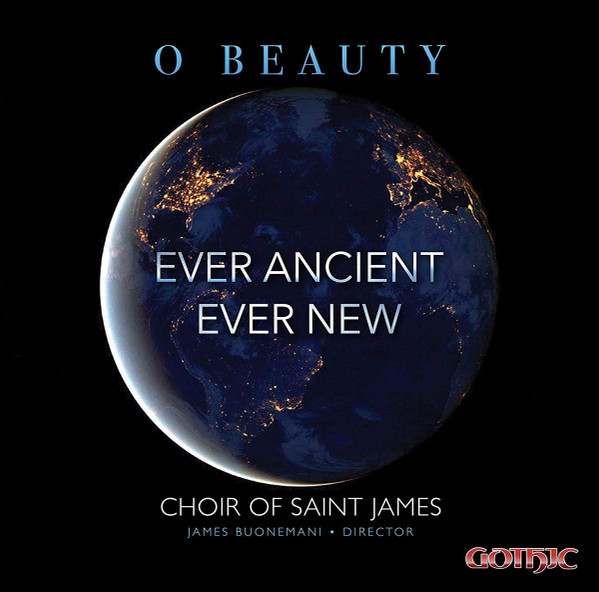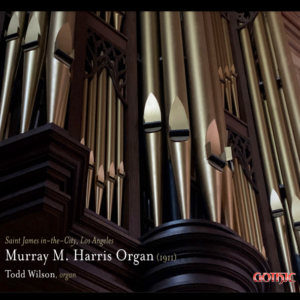The Choir of St. James – “O Beauty Ever Ancient Ever New”
$15.00
Track Listing:
- Salve Regina for Five Voices (Part 1) – (Cristóbal de Morales)
- Magnificat (Merton College, Oxford) – (Ēriks Ešenvalds)
- Nunc Dimittis (Merton College, Oxford) – (Ešenvalds)
- Agnus Dei, Missa Miamiensis – (James Buonemani)
- Second Eve – (Ola Gjeilo)
- My Love (A Celtic Prayer) – (Buonemani)
- Dum medium silentium – (Vytautas Miškinis)
- Timor et tremor, Quatre Motets pour un temps de pénitence – (Francis Poulenc)
- A Litany – (William Walton)
- Let all mortal flesh keep silence – (Edward Bairstow)
- O Beauty Ever Ancient Ever New – (Buonemani)
The choir’s first commercially available CD is now available worldwide! We are grateful to Dr. Christopher Gravis, husband of long-time chorister Andrea Zomorodian, for his insightful introductory notes to the CD: “ … a musical reflection of a mystical spirituality that is rooted in the ancient, while simultaneously surging forward into the unknown. It is both old and new, eschewing the temporal. It is eternal.”
Featuring the contemporary music of Baltic composers Miškinis, Ešenvalds, and Geilo alongside the established Anglican composers Walton and Bairstow, the album also includes Poulenc’s Lenten masterpiece “Timor et tremor” and three compositions by conductor James Buonemani including the title work written in 2011 for the 100th Anniversary of St. James Church, premiered in May of 2012. Anchoring this mostly contemporary selection of music is the profound “Salve Regina” by the 16th century Spanish composer Cristóbal de Morales.
Regarding the title work, Buonemani writes:
Humans have always celebrated the cycle of life, where death is the gateway to birth, and birth to death, in ritual and song – a retelling of ancient stories in new and immediate ways. These are the ineffable mysteries of Christianity, and indeed, of all life: a Beauty Ever Ancient Ever New.
REVIEWS:
Association of Anglican Musicians Journal – March 2019
Many reviews often begin with the phrase “this artist/performer/musician needs no introduction in this field”. Not so for this writer; James Buonemani and St. James Episcopal Church in Los Angeles are entirely new to me. To be introduced to them through this recording has been a musical highlight of my year. It is tempting to say that this work belongs in everyone’s library, but personally, I have only purchased a handful of CD’s after reading a critique. I hope that this CD would have somehow fallen into my hands had I not found it for review. Both Buonemani and Sherman graciously answered questions and commented on the recording via email and telephone calls.
O Ever Ancient Ever New not only displays the dichotomy of this phrase by Augustine of Hippo in his Confessions, but also showcases it in this exquisite recording. What Buonemani is trying to do is evident: look back to what is known while looking ahead to what is not. He achieves this by carefully choosing choral works that span centuries and does so gracefully.
Buonemani starts the journey he has created with 16th-century Spanish composer Cristobal de Morales’ Salve Regina, ingeniously programed at the beginning of the recording in order to welcome us onto the road we travel. He calls it the “anchor” of the album, with the compositions following as continuation of it.
The musical forces could not be better. It takes an exacting choir to carefully tune Poulenc’s “Timor et Tremor” and these singers do it. The instrumental accompaniments are beautiful. The first time one hears the piano played, it isn’t the percussiveness of the keyboard that we hear, but the tones themselves. It isn’t lost on the listener that this is because of the genius of the recording technique itself; Sherman cleverly recorded the piano via placement of the microphones. He did the same thing with the a cappella works. One could hope for more music between Morales and Bairstow, but the more you hear the recording, the more you realize that “filling-in” for the sake of doing so isn’t necessary. Buonemani’s own compositions weave themselves into the tapestry of the album, enhancing its content. His works stand-up nicely to those of other contemporary composers: Esenvalds, Gjello and Miskinis; Buonemani’s writing goes right along with these titans of 21st-century composition.
The venue for recording was All Souls Chapel at Good Samaritan Hospital, an institution of the Episcopal Diocese of L.A. While each piece is immensely satisfying, the a cappella works stand-out for the creativity of how they were recorded: Sherman explains that “the choir was in an oval shape (dictated in part by the size and shape of the room). I placed three mics in the middle of the oval, which made each mic approximately equal distant from the choir.” The conductor stood at one end of the oval.
Accompaniments come-across as they should: collaborative and supportive, without overwhelming. Again, it was Sherman’s miking of all contributors which allows us to hear the voices being accompanied by the instruments and not the other way around. The choir was on one side of the room, the instrumentalists opposite, with the conductor in the middle.
The icing on the cake to this great recording is the beautiful booklet accompanying it, with its detailed liner notes providing a glimpse into each work. Despite knowing three of the anthems intimately, I have never read such insightful descriptions of each motet.
When I asked Buonemani what the impetus was for the recording, he explained that it came from writing what would become the album’s title track, “O Beauty Ever Ancient Ever New”, a quote from St. Augustine of Hippo. The words, he said, kept working-on him, until “it was just a good time to construct an album of choral music that reflected the wondrous truth of these words.” What he set-out to do, he achieved: here is a recording with carefully chosen music that fits the theme. This CD is nothing short of genius in its conception and execution. The dichotomy of past/present poetry comes to light in all that one hears.
Perhaps there is no better description of this recording than from the liner notes themselves, particularly in Gravis’ description of the Esenvalds Magnificat : “Young Mary’s antiphon concludes with an ensemble exclamation of Amen that seems to solemnly encapsulate the warm exuberance of admiring angelic choirs.” Saint James is, indeed, an angelic choir. – John Palmer
American Record Guide 7-8 2019
This is the first commercially available CD of this Los Angeles-based choir. The album opens with Morales’s ‘Salve Regina,’ a stunning piece of 16th century polyphony, sung with pristine purity, setting a dangerously high bar. Yet the 20th and 21st century works do not let us down. James Buonemani is the main composer. His ‘Celtic Prayer’ moves in contrary motion toward a sonorous climax and a deeply satisfying cadence. The title work, ‘O Beauty Ever Ancient Ever New,’ fuses ancient and contemporary motifs. It is richly orchestrated (the excellent ensemble is simply called “the Orchestra for O Beauty”) and sounds a bit like Duruflé but has its own seductive personality. Listen to the magic horn sonority blending with the choir and organ at the end.
The Magnificat and Nunc Dimittis of Baltic composer Erik Esenvalds have gentle dissonance and soaring solo lines. Poulenc’s motet, ‘Timor et Tremor,’ is hauntingly beautiful, as we would expect. The cadence is breathtaking. Ola Gjeilo’s tuneful ‘Second Eve’ has inviting homophonic textures and beguiling modal harmonies.
The most challenging item is Walton’s ‘Litany,’ full of harmonic quirkiness and surprise – a strangely unsettling piece, inventive and melancholy. I would never have guessed it was by Walton. The requisite minimalist work, ‘Dum Medium Silentium’ by Vautatis Miskinis, casts a delicate spell. ‘Let All Mortal Flesh Keep Silence’ by Edward Bairstow, is the opposite – a meaty, imposing work.
The warm acoustic, with just the right amount of reverberance, establishes a reverent atmosphere. This is a wonderful choral collection, full of variety and adventure, mostly radiant and serene but with moments of melancholy and subtle disturbance. – Jack Sullivan



Reviews
There are no reviews yet.